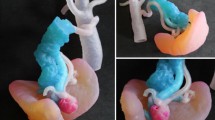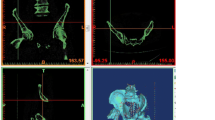Abstract
Purpose
Virtual digital resources and printed models have become indispensable tools for medical training and surgical planning. Nevertheless, printed models of soft tissue organs are still challenging to reproduce. This study adopts open source packages and a low-cost desktop 3D printer to convert multiple modalities of medical images to digital resources (volume rendering images and digital models) and lifelike printed models, which are useful to enhance our understanding of the geometric structure and complex spatial nature of anatomical organs.
Materials and methods
Neuroimaging technologies such as CT, CTA, MRI, and TOF-MRA collect serial medical images. The procedures for producing digital resources can be divided into volume rendering and medical image reconstruction. To verify the accuracy of reconstruction, this study presents qualitative and quantitative assessments. Subsequently, digital models are archived as stereolithography format files and imported to the bundled software of the 3D printer. The printed models are produced using polylactide filament materials.
Results
We have successfully converted multiple modalities of medical images to digital resources and printed models for both hard organs (cranial base and tooth) and soft tissue organs (brain, blood vessels of the brain, the heart chambers and vessel lumen, and pituitary tumor). Multiple digital resources and printed models were provided to illustrate the anatomical relationship between organs and complicated surrounding structures. Three-dimensional printing (3DP) is a powerful tool to produce lifelike and tangible models.
Conclusions
We present an available and cost-effective method for producing both digital resources and printed models. The choice of modality in medical images and the processing approach is important when reproducing soft tissue organs models. The accuracy of the printed model is determined by the quality of organ models and 3DP. With the ongoing improvement of printing techniques and the variety of materials available, 3DP will become an indispensable tool in medical training and surgical planning.








Similar content being viewed by others
References
Winkelmann A (2007) Anatomical dissection as a teaching method in medical school: a review of the evidence. Med Educ 41(1):15–22. doi:10.1111/j.1365-2929.2006.02625.x
Sugand K, Abrahams P, Khurana A (2010) The anatomy of anatomy: a review for its modernization. Anat Sci Educ 3(2):83–93. doi:10.1002/ase.139
McMenamin PG, Quayle MR, McHenry CR, Adams JW (2014) The production of anatomical teaching resources using three-dimensional (3D) printing technology. Anat Sci Educ 7(6):479–486. doi:10.1002/ase.1475
AbouHashem Y, Dayal M, Savanah S, Štrkalj G (2015) The application of 3D printing in anatomy education. Med Educ Online 20:29847. doi:10.3402/meo.v20.29847
Li Z, Li Z, Xu R, Li M, Li J, Liu Y, Sui D, Zhang W, Chen Z (2015) Three-dimensional printing models improve understanding of spinal fracture–a randomized controlled study in China. Sci Rep 5:11570. doi:10.1038/srep11570
Drebin RA, Carpenter L, Hanrahan P (1988) Volume rendering. SIGGRAPH Comput Graph 22(4):65–74. doi:10.1145/54852.378484
Rengier F, Mehndiratta A, von Tengg-Kobligk H, Zechmann CM, Unterhinninghofen R, Kauczor HU, Giesel FL (2010) 3D printing based on imaging data: review of medical applications. Int J CARS 5(4):335–341. doi:10.1007/s11548-010-0476-x
Noguera JM, Jiménez JJ, Osuna-Pérez MC (2013) Development and evaluation of a 3D mobile application for learning manual therapy in the physiotherapy laboratory. Comput Educ 69:96–108. doi:10.1016/j.compedu.2013.07.007
Preece D, Williams SB, Lam R, Weller R (2013) “Let’s get physical”: advantages of a physical model over 3D computer models and textbooks in learning imaging anatomy. Anat Sci Educ 6(4):216–224. doi:10.1002/ase.1345
Levy RA, Guduri S, Crawford RH (1994) Preliminary experience with selective laser sintering models of the human temporal bone. Am J Neuroradiol 15(3):473–477
Wagner JD, Baack B, Brown GA, Kelly J (2004) Rapid 3-dimensional prototyping for surgical repair of maxillofacial fractures: a technical note. J Oral Maxillofac Surg 62(7):898–901. doi:10.1016/j.joms.2003.10.011
Malik HH, Darwood AR, Shaunak S, Kulatilake P, El-Hilly AA, Mulki O, Baskaradas A (2015) Three-dimensional printing in surgery: a review of current surgical applications. J Surg Res 199(2):512–522. doi:10.1016/j.jss.2015.06.051
Darwood A, Collier J, Joshi N, Grant WE, Sauret-Jackson V, Richards R, Dawood A, Kirkpatrick N (2015) Re-thinking 3D printing: a novel approach to guided facial contouring. J Craniomaxillofac Surg 3(7):1256–1260. doi:10.1016/j.jcms.2015.06.001
Waran V, Devaraj P, Hari Chandran T, Muthusamy KA, Rathinam AK, Balakrishnan YK, Tung TS, Raman R, Rahman ZA (2012) Three-dimensional anatomical accuracy of cranial models created by rapid prototyping techniques validated using a neuronavigation station. J Clin Neurosci 19(4):574–577. doi:10.1016/j.jocn.2011.07.031
Lee MY, Chang CC, Ku YC (2008) New layer-based imaging and rapid prototyping techniques for computer-aided design and manufacture of custom dental restoration. J Med Eng Technol 1:83–90. doi:10.1080/03091900600836642
Giannatsis J, Dedoussis V (2007) Additive fabrication technologies applied to medicine and health care: a review. Int J Adv Manuf Technol 40(1–2):116–127. doi:10.1007/s00170-007-1308-1
Vaccarezza M, Papa V (2015) 3D printing: a valuable resource in human anatomy education. Anat Sci Int 90(1):64–65. doi:10.1007/s12565-014-0257-7
Ebert LC, Thali MJ, Ross S (2011) Getting in touch-3D printing in forensic imaging. Forensic Sci Int 211(1–3):e1–6. doi:10.1016/j.forsciint.2011.04.022
Marro A, Bandukwala T, Mak W (2016) Three-dimensional printing and medical imaging: a review of the methods and applications. Curr Probl Diagn Radiol 45(1):2–9. doi:10.1067/j.cpradiol.2015.07.009
Silva DN, Gerhardt de Oliveira M, Meurer E, Meurer MI, Lopes da Silva JV, Santa-Barbara A (2008) Dimensional error in selective laser sintering and 3D-printing of models for craniomaxillary anatomy reconstruction. J Craniomaxillofac Surg 36(8):443–449. doi:10.1016/j.jcms.2008.10.008
Schroeder WJ, Ibáñez L, Martin KM (2004) Software process: the key to developing robust, reusable and maintainable open-source software. IEEE Int Symp Biomed Imaging (1):648–651. doi:10.1109/ISBI.2004.1398621
Vincent L, Soille P (1991) Watersheds in digital spaces: an efficient algorithm based on immersion simulations. IEEE T Pattern Anal 13(6):583–598. doi:10.1109/34.87344
Osher S, Fedkiw RP (2001) Level set methods: an overview and some recent results. J Comput Phys 169(2):463–502. doi:10.1006/jcph.2000.6636
Lorensen WE, Cline HE (1987) Marching cubes: a high resolution 3D surface construction algorithm. SIGGRAPH Comput Graph 21(4):163–169. doi:10.1145/37402.37422
He HG, Tian J, Zhao MC, Yang H (2002) A 3D medical imaging surface reconstruction scheme based on segmentation. J Softw 13(2):219–226
Cignoni P, Callieri M, Corsini M, Dellepiane M, Ganovelli F, Ranzuglia G (2008) Meshlab: an open-source mesh processing tool. Eurographics Ital Chapt Conf 2008:129–136
Zhang L, Dong H, Saddik AE (2015) From 3D sensing to printing: a survey. ACM T Multim Comput 12(2):27. doi:10.1145/2818710
Shui WY, Zhou MQ, Geng GH (2009) Automatic brain tissue extraction approach of magnetic resonance head images. J Softw 20(5):1139–1145
Fredieu JR, Kerbo J, Herron M, Klatte R, Cooke M (2015) Anatomical models: a digital revolution. Med Sci Educ 25(2):183–194. doi:10.1007/s40670-015-0115-9
McGurk M, Amis A, Potamianos P, Goodger N (1997) Rapid prototyping techniques for anatomical modelling in medicine. Ann R Coll Surg Engl 79(3):169–174
Salmi M, Paloheimo KS, Tuomi J, Wolff J, Makitie A (2013) Accuracy of medical models made by additive manufacturing (rapid manufacturing). J Craniomaxillofac Surg 41(7):603–609. doi:10.1016/j.jcms.2012.11.041
Fasel JH, Beinemann J, Schaller K, Gailloud P (2013) A critical inventory of preoperative skull replicas. Ann R Coll Surg Engl 95(6):401–404. doi:10.1308/003588413X13629960046994
Huotilainen E, Jaanimets R, Valasek J, Marcian P, Salmi M, Tuomi J, Makitie A, Wolff J (2014) Inaccuracies in additive manufactured medical skull models caused by the DICOM to STL conversion process. J Craniomaxillofac Surg 42(5):e259–265. doi:10.1016/j.jcms.2013.10.001
Ma B, Kunz M, Gammon B, Ellis RE, Pichora DR (2014) A laboratory comparison of computer navigation and individualized guides for distal radius osteotomy. Int J CARS 9(4):713–724. doi:10.1007/s11548-013-0966-8
Lambrecht JT, Berndt DC, Schumacher R, Zehnder M (2009) Generation of three-dimensional prototype models based on cone beam computed tomography. Int J CARS 4(2):175–180. doi:10.1007/s11548-008-0275-9
Weiss TL, Zieselman A, Hill DP, Diamond SG, Shen L, Saykin AJ, Moore JH (2015) The role of visualization and 3-D printing in biological data mining. BioData Min 8(1):1–7. doi:10.1186/s13040-015-0056-2
Watson RA (2014) A low-cost surgical application of additive fabrication. J Surg Educ 71(1):14–17. doi:10.1016/j.jsurg.2013.10.012
Naftulin JS, Kimchi EY, Cash SS (2015) Streamlined, inexpensive 3D printing of the brain and skull. PloS One 10(8):e0136198. doi:10.1371/journal.pone.0136198
Wu A-M, Shao Z-X, Wang J-S, Yang X-D, Weng W-Q, Wang X-Y, Xu H-Z, Chi Y-L, Lin Z-K (2015) The accuracy of a method for printing three-dimensional spinal models. PloS One 10(4):e0124291. doi:10.1371/journal.pone.0124291
Acknowledgments
The authors would like to thank the anonymous reviewers. This work is supported by the National Science Foundation of China (61402042) and Beijing Natural Science Foundation (4152028).
Author information
Authors and Affiliations
Corresponding author
Ethics declarations
Conflict of interest
The authors, Wuyang Shui, Mingquan Zhou, Shi Chen, Zhouxian Pan, Qingqiong Deng, Yong Yao, Hui Pan, Taiping He, Xingce Wang, have declared that no competing interests exist.
Ethical approval
The local ethics committee considered that this study had been carried out in accordance with the Declaration of Helsinki.
Informed consent
Informed consent was obtained from all patients for being included in the study.
Rights and permissions
About this article
Cite this article
Shui, W., Zhou, M., Chen, S. et al. The production of digital and printed resources from multiple modalities using visualization and three-dimensional printing techniques. Int J CARS 12, 13–23 (2017). https://doi.org/10.1007/s11548-016-1461-9
Received:
Accepted:
Published:
Issue Date:
DOI: https://doi.org/10.1007/s11548-016-1461-9




